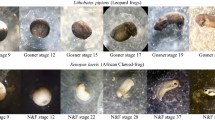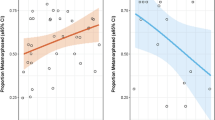Abstract
Land-use change can alter the energy dynamics in aquatic systems by changing the subsidies that form the nutrient base within them. However, experimental evaluations of subsidy change often fail to consider how effects, such as differences in individual growth and survival, may differ under varying ecological contexts experienced in the field. We used a mesocosm approach to investigate how litter (Native Prairie or Non-Native Tall-Fescue Grass) surrounding wetlands and timing of oviposition affected larval amphibian development. We found that survival differed between litter types in the Early-Oviposition treatment, with nearly 100% mortality in Fescue treatments. Conversely, survival was similar across litter types in the Late Oviposition treatment (~ 43%), and larvae in Late-Fescue treatments metamorphosed more quickly and were larger post-metamorphosis than larvae in Prairie treatments. Follow-up experiments confirmed that low dissolved oxygen (DO) was responsible for high mortality in Early-Fescue treatments; high quantities of Fescue resulted in a microbial bloom that reduced DO to < 2 mg/L for several days, resulting in low hatching success. This effect was eliminated in treatments with supplemental aeration. Finally, we confirmed that experimentally observed DO patterns also occurred in the field. Context (i.e., timing of inundation relative to amphibian breeding) is critical to understanding the effects of subsidies on amphibian populations; early and explosively breeding species may experience catastrophic mortality due to DO depletion; whereas, species that breed later may experience enhanced fitness of recruits. Considering the effects of non-native species across different ecological contexts is necessary for elucidating the extent of their impacts.






Similar content being viewed by others
Data availability
The datasets generated during the current study are available as an electronic supplement with this manuscript.
References
Adams CK, Saenz D (2012) Leaf litter of invasive Chinese tallow (triadica sebifera) negatively affects hatching success of an aquatic breeding anuran, the southern leopard frog (Liithobates sphenocephalus). Can J Zool 90:991–998
Aerts R, de Caluwe H (1997) Initial litter respiration as indicator for long-term leaf litter decomposition of Carex species. Oikos 80:353–361
Agrawal AA, Ackerly DD, Adler F, Arnold AE, Cáceres C, Doak DF, Post E, Hudson PJ, Maron J, Mooney KA, Power M (2007) Filling key gaps in population and community ecology. Front Ecol Environ 5:145–152
APHA (2005) Standard methods for the examination of water and wastewater. In: Eaton AE, Clesceri LS, Rice EW, Greenberg AE, Franson MAH (eds), 21st edn, American Public Health Association, Washington
Baecher JA, Vogrinc PN, Guzy JC, Kross CS, Willson JD (2018) Herpetofaunal communities in restored and unrestored remant tallgrass prairie and associated wetlands in Northwest Arkansas, USA. Wetlands 38:157–168
Battle JM, Golladay SW (2001) Hydroperiod influence on breakdown of leaf litter in cypress-gum wetlands. Am Midl Nat 146:128–145
Bradford DF (1983) Winterkill, oxygen relations, and energy metabolism of a submerged dormant amphibian, Rana mucosa. Ecology 64:1171–1183
Burggren WW, West NH (1982) Changing respiratory importance of gills, lungs, and skin during metamorphosis in the bullfrog Rana catesbeiana. Respir Physiol 47:151–164
Cabrera-Guzmán E, Crossland MR, Brown GP, Shine R (2013) Larger body size at metamorphosis enhances survival, growth, and performance of young cane toads (Rhinella marina). PLoS ONE 8:e701772. https://doi.org/10.1371/journal.pone.0070121
Carpenter SR, Kitchell JF, Hodgson JR (1985) Cascading trophic interactions and lake productivity. Bioscience 35:634–639
Carpenter SR, Cole JJ, Hodgson JR, Kitchell JF, Pace ML, Bade D, Cottingham KL, Essington TE, Houser JN, Schindler DE (2001) Trophic cascades, nutrients, and lake productivity: whole-lake experiments. Ecol Monogr 71:163–186
Cherney JH (2007) Tall fescue for forage production. Forage Information. Purdue University. https://www.agry.purdue.edu/ext/forages/publications/ay98.htm
Cohen JS, Maerz JC, Blossey B (2012) Traits, not origin, explain impacts of plants on larval amphibians. Ecol Appl 22:218–228
Comer PJ, Hak JC, Kindscher K, Muldavin E, Singhurst J (2018) Continent-scale landscape conservation design for temperate grasslands of the Great Plains and Chihuahuan Desert. Nat Areas J 38:196–211
Development Core Team R (2018) R: a language and environment for statistical computing. R Foundation for Statistical Computing, Vienna
Earl JE, Semlitsch RD (2013) Spatial subsidies, trophic state, and community structure: examining effects of leaf litter on ponds. Ecosystems 16:639–651
Earl JE, Castello PO, Cohagen KE, Semlitsch RD (2014) Effects of subsidy quality on reciprocal subsidies: how leaf litter species changes frog biomass export. Oecologica 175:209–218
Entrekin SA, Tank TL, Rosi-Marshall EJ, Hoellein TJ, Lamberti GA (2008) Responses in organic matter accumulation and processing to an experimental wood addition in three headwater streams. Freshw Biol 53:1642–1657
Feder ME (1983a) Responses to acute aquatic hypoxia in larvae of the frog Rana berlandieri. J Exp Biol 104:79–95
Feder ME (1983b) Effect of hypoxia and body size on the energy metabolism of lungless tadpoles, Bufo woodhousei, and air-breathing anuran larvae. J Exp Zool 228:11–19
Fish D, Carpenter SR (1982) Leaf litter and larval mosquito dynamics in tree-hole ecosystems. Ecology 63:283–288
Foster D, Swanson F, Aber J, Burke I, Brokaw N, Tilman D, Knapp A (2003) The importance of land-use legacies to ecology and conservation. Bioscience 53:77–88
Fuell AK, Entrekin SA, Owen GS, Owen SK (2013) Drivers of leaf decomposition in two wetland types in the Arkansas River Valley, USA. Wetlands 33:1127–1137
Gosner KL (1960) A simplified table for staging anuran embryos and larvae with notes on identification. Herpetologica 16:183–190
Hall RO, Meyer JL (1998) The trophic significance of bacteria in detritus-based stream food web. Ecology 79:1995–2012
Hall RO, Wallace JB, Eggert SL (2000) Organic matter flow in stream food webs with reduced detrital resource base. Ecology 81:3445–3463
Hammerson GM Parris (2004) Lithobates areolatus. The IUCN Red List of Threatened Species 2004:e.T58546A11799946. https://doi.org/10.2305/IUCN.UK.2004.RLTS.T58546A11799946.en
Henwood WD (2010) Toward a strategy for the conservation and protection of the world’s temperate grasslands. Great Plains Res 20:121–134
Knutson MG, Richardson WB, Reineke DM, Gray BR, Parmelee JR, Weick SE (2004) Agricultural ponds support amphibian populations. Ecol Appl 14:669–684
Leroux SJ, Loreau M (2008) Subsidy hypothesis and strength of trophic cascades across ecosystems. Ecol Lett 11:1147–1156
Maerz JC, Brown CJ, Chapin CT, Blossey B (2005) Can secondary compounds of an invasive plant affect larval amphibians? Funct Ecol 19:970–975
Maerz JC, Cohen JS, Blossey B (2010) Does detritus quality predict the effect of native and nonnative plants on the performance of larval amphibians? Freshw Biol 55:1694–1704
Mallin MA, Johnson VL, Ensign SH, MacPherson TA (2006) Factors contributing to hypoxia in rivers, lakes, and streams. Limnol Oceanogr 51:690–701
Meyer JL (1994) The microbial loop in flowing waters. Microb Ecol 28:195–199
Miller JH (2003) Nonnative invasive plants of southern forests: a field guide to identification and control, vol 62. US Department of Agriculture, Forest Service, Southern Research Station
Pace ML, Cole JC, Carpenter SR, Kitchell JF, Hodgson JR, Van de Bogert MC, Bade DL, Kritzberg DL, Bastviken D (2004) Whole-lake carbon-13 additions reveal terrestrial support of aquatic food webs. Nature 427:240–243
Polis GA, Anderson WB, Holt RD (1997) Toward an integration of landscape and food web ecology: the dynamics of spatially subsidized food webs. Annu Rev Ecol Syst 28:289–316
Rogalski MA, Skelly DK (2012) Positive effects of nonnative invasive Phragmites australis on larval bullfrogs. PLoS ONE 7(8):e44420. https://doi.org/10.1371/journal.pone.0044420
Rosemond AD, Mulholland PJ, Elwood JW (1993) Top-down and bottom-up control of stream periphyton growth: effects of nutrients and herbivores. Ecology 74:1264–1280
Rubbo MJ, Kiesecker JM (2004) Leaf litter composition and community structure: translating regional species changes into local dynamics. Ecology 85:2519–2525
Rubbo MJ, Belden LK, Kiesecker JM (2006) Differential responses of aquatic consumers to variations in leaf-litter inputs. Hydrobiologia 605:37–44
Sacerdote AB, King RB (2009) Dissolved oxygen requirements for hatching success of two ambystomatid salamanders in restored ephemeral wetlands. Wetlands 29:1202–1213
Samson FB, Knopf FL (1994) Prairie conservation in North America. Bioscience 44:418–421
Samson FB, Fl Knopf, Ostlie WR (2004) Great plains ecosystems: past, present, and future. Wildl Soc Bull 32:6–15
Semlitsch RD (1983) Growth and metamorphosis of larval red salamanders (Pseudotriton ruber) on the coastal plain of South Carolina. Ecology 39:48–52
Semlitsch RD (1987) Relationship of pond drying to reproductive success of the salamander Ambystoma talpoideum. Copeia 1987:61–69
Semlitsch RD, Scott DE, Pechmann JHK (1988) Time and size at metamorphosis related to adult fitness in Ambystoma talpoideum. Ecology 69:184–192
Sleper DA, West CP (1996) Tall Fescue. In: Moser LE, Buxton DR, Casler MD (eds) Cool-season forage grasses. American Society of Agronomy; Crop Science, Society of America; Soil Science Society of America, Madison, pp 471–502
Smith DC (1987) Adult recruitment in chorus frogs: effects of size and date at metamorphosis. Ecology 68:344–350
Stephens JP, Berven KA, Tiegs SD (2013) Anthropogenic changes to leaf litter input affect the fitness of a larval amphibian. Freshw Biol 58:1631–1646
Stoler AB, Relyea RA (2011) Living in the litter: the influence of tree leaf litter on wetland communities. Oikos 120:862–872
Stream Solute Workshop (1990) Concepts and methods for assessing solute dynamics in stream ecosystems. J N Am Benthol Soc 9:95–119
Trauth SE, Robison HW, Plummer MV (2004) The amphibians and reptiles of arkansas. The University of Arkansas Press, Fayetteville, pp 166–167
Watling JI, Hickman CR, Lee E, Wang K, Orrock JL (2011a) Extracts of the invasive Lonicera maackii increase mortality and alter behavior of amphibian larvae. Oecologia 165:153–159
Watling JI, Hickman CR, Orrock JL (2011b) Predators and invasive plants affect performance of amphibian larvae. Oikos 120:735–739
Webster JR, Benfield EF (1986) Vascular plant breakdown in freshwater ecosystems. Annu Rev Ecol Syst 17:567–594
Wilcox HS, Wallace JB, Meyer JL, Benstead JP (2005) Effects of labile carbon addition on a headwater stream food web. Limnol Oceanogr 50:1300–1312
Williams BK, Rittenhouse TAG, Semlitsch RD (2008) Leaf litter input mediates tadpole performance across forest canopy treatments. Oecologia 155:377–384
Acknowledgements
Funding for this project was partially provided by the National Science Foundation (NSF DBI 1659857) and the University of Arkansas, as well as Prairie Biotic Research and the Arkansas Audubon Society Trust. We thank Mackenzie Bramlett, Jessika Dorcas, Logan Estes, Dr. Jackie Guzy, Kelly Halloran, Micalea Klaus, David Reed, Meredith Swartwout, and Phil Vogrinc for help in vegetation and data collection. We thank Dr. Jennifer Mortensen for assisting in data analysis in the egg hatching experiment and data collection. Thank you to Erik Pollock and Lindsey Conaway, from the University of Arkansas Stable Isotope Laboratory, for running nutrient analyses. We also thank Dr. Hal Halvorson for running preliminary nutrient tests. Thank you to Drs Steve Beaupre, Jeff Briggler, and Dan Magoulick for project guidance and comments on early versions of this manuscript. Additionally, we thank Ethan Royal and three reviewers for their comments that improved this manuscript. For site access and support, we thank the City of Fayetteville and Woolsey Wet Prairie Sanctuary, especially Jeff Hickle and Bruce Shackleford.
Author information
Authors and Affiliations
Contributions
CSK and JDW conceived the ideas and designed methodology; CSK, AKD, and PLM collected the data; CSK and AKD analyzed the data, CSK led the writing of the manuscript, comments from JDW improved the manuscript. All authors gave final approval for publication.
Corresponding author
Ethics declarations
Conflict of interest
The authors declare they have no conflict of interest.
Animal rights
All applicable institutional and national guidelines for the care and use of animals and were approved and followed (IACUC protocol #’s 15033 and 17079).
Additional information
Communicated by Howard Whiteman.
Electronic supplementary material
Below is the link to the electronic supplementary material.
Rights and permissions
About this article
Cite this article
Kross, C.S., Dodd, A.K., Mariage, P.L. et al. Timing of oviposition influences the effects of a non-native grass on amphibian development. Oecologia 194, 113–122 (2020). https://doi.org/10.1007/s00442-020-04744-3
Received:
Accepted:
Published:
Issue Date:
DOI: https://doi.org/10.1007/s00442-020-04744-3




